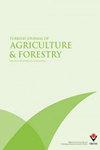Analysis of morphological and pomological features of apricot in the Nakhchivan Autonomous Republic of Azerbaijan
IF 3
2区 农林科学
Q1 AGRONOMY
引用次数: 1
Abstract
: Apricot ( Prunus armeniaca L.) is grown across a wide geographical area and has been cultivated in Azerbaijan for more than three thousand years. The purpose of the study was to characterize the apricot varieties and forms collected from the Nakhchivan Autonomous Republic of Azerbaijan. Fourty-four apricot varieties and forms were studied according to 10 (phenological, pomological, morphological) parameters. A wide variation was found between yield, total soluble solids and fruit weight among varieties and forms. Fruits of the most of apricot varieties and forms were small, only two of them—Hampa and Limon Erik 2—had a fruit weight more than 50 g. In general, the fruits had yellow skin and flesh with high total soluble solids (TSS). Five varieties are characterized by orange, two by white, and three by yellowish-green skin ground color (SGC). A high correlation was found between several morphological and pomological features. Maximum Pearson correlation indices were found between bud break season and blossom season, fruit weight and fruit length, blossom season and harvest season. Fruits that were longer and wider had high fruit weight. The results of the PC (principal component) analysis revealed the first four components (PC1 - PC4) explained by 87.49% of the variance observed between varieties and forms. The presented study shows that the more attractive and yellow-skinned Azerbaijani apricot varieties and forms are suitable to produce dried apricots. Data from statistical analysis can be used to select different varieties and forms for apricot breeding programs. The research will provide a solid basis for the effective management and sustainable use of apricot germplasms for future breeding programs in the region.阿塞拜疆纳希切万自治共和国杏树形态与果学特征分析
杏(Prunus armeniaca L.)生长在广阔的地理区域,在阿塞拜疆已经种植了三千多年。这项研究的目的是描述从阿塞拜疆纳希切万自治共和国收集的杏的品种和形式。根据物候、果学、形态等10个参数,对44个杏品种和形态进行了研究。品种和品种间的产量、总可溶性固形物和果实重差异很大。大多数杏品种和品种的果实都很小,只有hampa和Limon Erik 2两个品种的果实重量超过50克。总体而言,果实果皮和果肉呈黄色,总可溶性固形物(TSS)较高。五个品种的特征是橙色,两个是白色,三个是黄绿色的皮肤底色(SGC)。在几个形态学和形态学特征之间发现了高度的相关性。发芽季节与开花季节、果重与果长、开花季节与采收季节的Pearson相关指数最大。果实越长越宽,果实质量越高。主成分分析结果显示,前4个成分(PC1 - PC4)解释了87.49%的品种和形态差异。所提出的研究表明,更具吸引力和黄皮阿塞拜疆杏品种和形式适合生产杏干。统计分析的数据可以用来选择不同的品种和形式的杏育种计划。该研究将为今后该地区杏树种质资源的有效管理和可持续利用提供坚实的基础。
本文章由计算机程序翻译,如有差异,请以英文原文为准。
求助全文
约1分钟内获得全文
求助全文
来源期刊
CiteScore
4.20
自引率
6.90%
发文量
42
审稿时长
12 months
期刊介绍:
The Turkish Journal of Agriculture and Forestry is published electronically 6 times a year by the Scientific and Technological Research Council of Turkey (TÜBİTAK).
It publishes, in English, full-length original research papers and solicited review articles on advances in agronomy, horticulture, plant breeding, plant protection, plant molecular biology and biotechnology, soil science and plant nutrition, bionergy and energy crops, irrigation, agricultural technologies, plant-based food science and technology, forestry, and forest industry products.

 求助内容:
求助内容: 应助结果提醒方式:
应助结果提醒方式:


